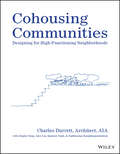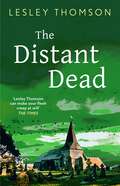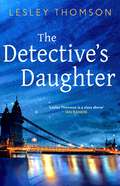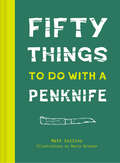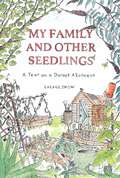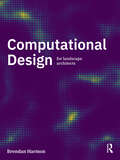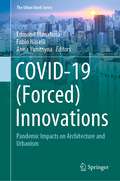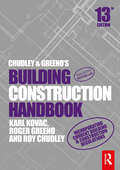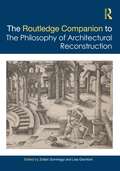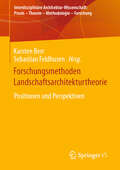- Table View
- List View
Mindful Homes: Create Healing Living Spaces With Mindfulness And Feng Shui
by Anjie ChoBe present and connected in your home with feng shui and mindfulness techniques. Feng shui teaches that we are interconnected and interdependent. This includes the spaces that we live in and engage with every day. We are not separate from our homes, our spaces or the objects and people that surround us. How can we begin to connect to and appreciate our world, and see the beauty in each moment? In Mindful Homes, discover how we can start by paying attention to the details around us. Feng shui and mindfulness can help us to slow down, be more aware and create spaciousness to give birth to more joy, creativity and community. Learn simple practices to cultivate a healing living space, including creating sacred areas for rituals, incorporating crystals, mindful meditation and offering gratitude to deities and to your home itself. With stunning photography throughout, Mindful Homes will inspire you to look at your environment with fresh eyes and create a space that enhances happiness and wellbeing.
Living Wild
by Hilton CarterIn Living Wild, bestselling 'plantfluencer', author, designer and family man Hilton Carter explores multiple ways to style your home with plants – and cultivate happiness along the way.. The therapeutic benefits of living with and tending plants are well known – they offer a connection to the natural world that nurtures our mental and physical health. In this, his latest book, Hilton shows how to create a lush, stylish space with flourishing plants that bring life to your home and promote a happy and contented mindset. He discusses interior design choices – choosing the right color scheme, textures and materials to showcase gorgeous greenery – then takes a deep dive into styling. From picking the perfect planter to statement plants and taking in centrepieces, living art and hanging planters plus outdoors spaces and plants for kids along the way, Living Wild is packed with interior design and styling ideas that blur the boundary beside inside and out. Finally, we visit 8 unique homes that have been plant styled by Hilton and take a detailed look at his top ten designer plants, along with care and info tips.
Cohousing Communities: Designing for High-Functioning Neighborhoods
by Charles DurrettExplore a groundbreaking and holistic new approach to designing community-first neighborhoods In Cohousing Communities: Designing for High-Functioning Neighborhoods, distinguished architect and affordable housing advocate Charles Durrett delivers a complete, start-to-finish guide for designing anything where the emphasis lies with the community. This book describes the consequential role that architecture and a healthy design process can play in the success of neighborhoods, churches, towns, and more. It’s an inspiring collection of ideas that prioritize high-functioning neighborhoods. In the book, the author draws on the success of hundreds of community-first projects to show readers how to design a project that addresses both timeless and modern challenges—from aging to climate change and racism—in its architecture and urban design. He compiles facts and concepts that are essential to the design of a high-functioning community, where people can participate in a way that reflects their values, improves their social connections, and retain their autonomy and privacy. Readers will also find: Ideas for town planning, street planning, and other town altering improvements Discussions of how developers can make better multifamily housing Explorations of how planners and politicians can make high-functioning neighborhoods a cornerstone of their community In-depth treatments of families who want to confirm that they’re choosing the right neighborhood Perfect for university students and professors who strive to see new ways to create neighborhoods, Cohousing Communities: Designing for High-Functioning Neighborhoods will also appeal to universities planning new neighborhoods for retired alumni or new housing for students and faculty. Praise for Charles Durrett and Cohousing Communities: “…Get and read Cohousing Communities… Read it from the front cover to the back cover. It’s The Bible of Cohousing. And, like The Bible, it needs to be STUDIED not just read. Mark it up w/ your questions. Highlight, underline, write in the margins, fold the corners… This way you will gather your understanding how building cohousing gets “done," create your pathway to “Getting It Built”… and, most importantly get everyone on the same page for working together.” -- Ann Zabaldo, Executive Director, Mid Atlantic Cohousing
Histories of Urban Planning and Political Power: European Perspectives
by Max Welch Guerra Victoria GrauUrban planning has always been a preeminent instrument of political power. In this volume, contributions from Europe and Latin America provide insight into the functions of planning under very different political and societal constellations over the last hundred years: dictatorships, parliamentary democracies, and illiberalism; capitalism and state socialism; state interventionism and neoliberalism; societies in times of peace and societies marked by colonial, civil, world, or cold wars.The dictatorships of the 1920s and 1930s made extensive use of the potential of planning for economic growth, for brutal repression, but also for the integration of certain population groups and as an effective means of propaganda. The legacy of these dictatorships still characterizes many European cities today and confronts planning with complex tasks. Dictatorial state socialism planned to establish a new social order with a particular technocratic rationality, which did not, however, cancel completely the tendential autonomy of the professional planning sphere. Parliamentary democracies and illiberal regimes have developed specific new practices of using planning to rebuild cities in the interests of neoliberal economic growth and populistic legitimization of power.Histories of Urban Planning and Political Power takes the next steps in significantly expanding our understanding of planning and politics. The book will be of interest to students and scholars of urbanism, urban/town planning, spatial planning, spatial politics, urban development, urban policies, and planning history and European history of the 20th century.The Open Access version of this book, available at http://www.taylorfrancis.com, has been made available under a Creative Commons Attribution-Non Commercial-No Derivatives (CC-BY-NC-ND) 4.0 license.
Histories of Urban Planning and Political Power: European Perspectives
by Victoria GrauUrban planning has always been a preeminent instrument of political power. In this volume, contributions from Europe and Latin America provide insight into the functions of planning under very different political and societal constellations over the last hundred years: dictatorships, parliamentary democracies, and illiberalism; capitalism and state socialism; state interventionism and neoliberalism; societies in times of peace and societies marked by colonial, civil, world, or cold wars.The dictatorships of the 1920s and 1930s made extensive use of the potential of planning for economic growth, for brutal repression, but also for the integration of certain population groups and as an effective means of propaganda. The legacy of these dictatorships still characterizes many European cities today and confronts planning with complex tasks. Dictatorial state socialism planned to establish a new social order with a particular technocratic rationality, which did not, however, cancel completely the tendential autonomy of the professional planning sphere. Parliamentary democracies and illiberal regimes have developed specific new practices of using planning to rebuild cities in the interests of neoliberal economic growth and populistic legitimization of power.Histories of Urban Planning and Political Power takes the next steps in significantly expanding our understanding of planning and politics. The book will be of interest to students and scholars of urbanism, urban/town planning, spatial planning, spatial politics, urban development, urban policies, and planning history and European history of the 20th century.The Open Access version of this book, available at http://www.taylorfrancis.com, has been made available under a Creative Commons Attribution-Non Commercial-No Derivatives (CC-BY-NC-ND) 4.0 license.
Misfits & Hybrids: Architectural Artifacts for the 21st-Century City
by Ferda KolatanContemporary cities are shaped by the unlikely adjacencies of objects that are vastly different in kind, origin, and scale: buildings, infrastructure, and other urban components that over time accumulate into mismatched configurations. However, despite the ubiquity of these oddities and their impact on the city, we rarely give them much consideration. In Misfits & Hybrids, Ferda Kolatan explores the untapped potential in these unexpected conditions for a new kind of architecture. A diverse array of projects, developed in Kolatan’s design studios at the University of Pennsylvania Weitzman School of Design, illustrates how hybrid artifacts can reveal the often overlooked cultural, socio-political, and material histories of a site, fostering design tactics invested in reinventing the existing. Set within the cosmopolitan megacities of Istanbul, Cairo, and New York, the projects are conceived as real fictions, conjuring novel narrative, aesthetic, and representational forms to reflect the pluralistic postindustrial city.
Misfits & Hybrids: Architectural Artifacts for the 21st-Century City
by Ferda KolatanContemporary cities are shaped by the unlikely adjacencies of objects that are vastly different in kind, origin, and scale: buildings, infrastructure, and other urban components that over time accumulate into mismatched configurations. However, despite the ubiquity of these oddities and their impact on the city, we rarely give them much consideration. In Misfits & Hybrids, Ferda Kolatan explores the untapped potential in these unexpected conditions for a new kind of architecture. A diverse array of projects, developed in Kolatan’s design studios at the University of Pennsylvania Weitzman School of Design, illustrates how hybrid artifacts can reveal the often overlooked cultural, socio-political, and material histories of a site, fostering design tactics invested in reinventing the existing. Set within the cosmopolitan megacities of Istanbul, Cairo, and New York, the projects are conceived as real fictions, conjuring novel narrative, aesthetic, and representational forms to reflect the pluralistic postindustrial city.
The Distant Dead: (The Detective's Daughter Book 8) (The Detective's Daughter #8)
by Lesley ThomsonA woman lies dead in a bombed-out house. A tragic casualty of the Blitz? Or something more sinister? Sixty years later, the detective's daughter unearths the truth... From the number 1 bestselling author of The Detective's Daughter.LONDON, 1940Several neighbours heard the scream of the woman in the bombed-out house. One told the detective she thought the lady had seen a mouse. Another said it wasn't his business what went on behind closed doors. None of them imagined that a trusting young woman was being strangled by her lover.TEWKESBURY, 2020Beneath the vast stone arches of Tewkesbury Abbey, a man lies bleeding, close to death. He is the creator of a true-crime podcast which now will never air. He was investigating the murder of a 1940s police pathologist – had he come closer to the truth than he realised?Stella Darnell has moved to Tewkesbury to escape from death, not to court it. But when this man dies in her arms, Stella, impelled to root out evil when she finds it, becomes determined to hunt down his killer and to bring the secrets he was searching for into the light...Praise for The Detective's Daughter series:'Lesley Thomson gets better and better' Ian Rankin'Cunningly plotted' Mick Herron'One of the most original characters in British crime fiction... Thomson's plots are original and she draws her characters with genuine affection' Sunday Times'In the best traditions of the classic whodunnit, this is Midsomer Murders for grown-ups' Jake Kerridge, Sunday Express'Gloriously well-written... Thomson creates a rich and sinister world that is utterly unique' William Shaw
Start Growing: A Year of Joyful Gardening for Absolute Beginners
by Daisy PayneEasy, budget-friendly, year-round gardening projects for complete beginners, from This Morning’s gardening expert.If you love house plants and you're ready to try something new . . . this is the book for you! Step away from your screen and discover the joys of growing and connecting with nature.Find simple step-by-step projects for every season accompanied by beautiful photography to guide you throughout. Whether you have a windowsill, patio, small patch of grass, allotment or more room to play with, you’ll find projects to suit your space. From growing salad on your windowsill and creating a houseplant haven in your bathroom to growing outdoor fruit and veg or creating a beautiful garden boarder, this book covers all your practical gardening basics and the tools you’ll need to start out with.
We Made a Garden
by Margery FishAn elegant new edition of a classic book from one of the twentieth century's greatest garden writers. This landmark work on creating a garden was first published in 1956 and has rarely been out of print since. We Made a Garden is the story of how Margery Fish, one of the leading British gardeners of the mid-20th century, and her husband Walter transformed an acre of wilderness into a stunning cottage garden, still open to the public at East Lambrook Manor, Somerset, England. Quirky and readable, this book details her creation of a world-renowned cottage garden, as well as her battles with Walter in the process, who preferred the standard suburban approach. In this beautiful and timeless work, she recounts the trials and tribulations, the successes and failures of her venture with ease and humour. Topics covered are colourful and diverse, ranging from the most suitable hyssop for the terraced garden through composting, hedges and making paths to the best time to lift and replant tulip bulbs. This book has been hailed as everything from a blueprint for the creation of a modern cottage garden to a feminist manifesto, and the author's practical knowledge, imaginative ideas and general good sense will encourage and inspire gardeners everywhere.
The Art and Philosophy of the Garden
by David Fenner Ethan FennerThe Art and Philosophy of the Garden offers the first authoritative and comprehensive philosophical discussion of the aesthetics of gardens. Philosopher David Fenner and horticulturist Ethan Fenner address such questions as: what is a garden? Are some gardens works of art? What does it mean to appreciate gardens aesthetically? Given that gardens are always changing in a variety of ways, how is it possible to compare, evaluate, or find meaning in them? How can we interpret gardens? How do we value gardens and gardening? While grounded in Western thought, Fenner and Fenner bring to bear global ideas and examples of gardens and gardening techniques. Inspired by a surge of philosophical interest in gardening, Fenner and Fenner argue that some gardens are indeed works of art. They explore how we might understand the aesthetic properties of gardens, and focus on what it means to "read" the formal aspects of gardens -- what the authors call "garden form" -- as a basis for interpreting a garden. They discuss the intersection of gardens/gardening and value: questions such as what sort of value gardens possess; whether and how ethics are relevant to gardens; how gardens may be evaluated and compared; and the value of the practice of gardening. This comprehensive philosophical discussion on the aesthetics of gardens and gardening will not only interest those concerned with garden theory but will interest any thoughtful and intellectually curious gardener.
The Art and Philosophy of the Garden
by David Fenner Ethan FennerThe Art and Philosophy of the Garden offers the first authoritative and comprehensive philosophical discussion of the aesthetics of gardens. Philosopher David Fenner and horticulturist Ethan Fenner address such questions as: what is a garden? Are some gardens works of art? What does it mean to appreciate gardens aesthetically? Given that gardens are always changing in a variety of ways, how is it possible to compare, evaluate, or find meaning in them? How can we interpret gardens? How do we value gardens and gardening? While grounded in Western thought, Fenner and Fenner bring to bear global ideas and examples of gardens and gardening techniques. Inspired by a surge of philosophical interest in gardening, Fenner and Fenner argue that some gardens are indeed works of art. They explore how we might understand the aesthetic properties of gardens, and focus on what it means to "read" the formal aspects of gardens -- what the authors call "garden form" -- as a basis for interpreting a garden. They discuss the intersection of gardens/gardening and value: questions such as what sort of value gardens possess; whether and how ethics are relevant to gardens; how gardens may be evaluated and compared; and the value of the practice of gardening. This comprehensive philosophical discussion on the aesthetics of gardens and gardening will not only interest those concerned with garden theory but will interest any thoughtful and intellectually curious gardener.
One Garden Against the World: In Search of Hope in a Changing Climate
by Kate Bradbury'If you ever doubted that you can help change the world, READ THIS BOOK.' CAROLINE LUCAS'The greatest existential crisis we face distilled into the crucible of a tiny piece of paradise.' CHRIS PACKHAMFive years after writing her first nature memoir, The Bumblebee Flies Anyway, Kate Bradbury has a new garden. It's busy: home to all sorts of wildlife, from red mason bees and bumblebees to house sparrows, hedgehogs and dragonflies. It seems the entire frog population of Brighton and Hove breeds in her small pond each spring, and now there are toads here, too. On summer evenings, Kate watches bats flit above her and for a moment, everything seems alright with the world. But she knows habitat loss remains a huge issue in gardens, the wider countryside and worldwide, and there's another, far bigger threat: climate change. Temperature increases are starting to bite, and she worries about what that will mean for our wildlife. In her uplifting new book, Kate writes passionately about how her climate-change anxiety pushes her to look for positive ways to keep going in a changing world. As in her first memoir, she invites you into her life, sharing stories of her mum's ongoing recovery and her adventures with her new rescue dog, Tosca. One Garden Against the World is a call to action for all of us – gardeners, communities and individuals – to do more for wildlife and more for the climate. Climate change and biodiversity loss go hand in hand, but if we work together, it's never too late to make a difference.
Smart Cities: Innovations, Challenges and Future Perspectives (S.M.A.R.T. Environments)
by Leonidas G. Anthopoulos Sushobhan Majumdar Vinay KandpalThis book aims to integrate new technologies and adaptation tools into the process of smart city planning. It also emphasizes the value and importance of modern technologies such as IoT and data science as a smart technology for the formation of a smart city. The authors believe that various technologies in a smart city will reduce all the problems for the sustainable growth and future prospects of the city. The first section of this book discusses the innovation of new technologies (AI, data science, block chain, etc.) that has flourished in recent decades which will make the city smarter. This section also describes that block chain and IoT (Internet of Things) are two transformative technologies that can greatly impact smart cities by enhancing security, improving transparency, and enabling efficient management of resources. The second section of the book explains about the uses of AI tools and smart technologies (like waste management, public safety and security) for the development and management of smart cities. This chapter also describes AI-powered systems that are integrated into smart buildings to optimize energy usage, enhance occupant comfort, and improve building management. These systems can adjust lighting and HVAC settings based on occupancy, learn user preferences, and provide personalized energy efficiency recommendations. The third portion of the book investigates the recent challenges and barriers of smart city that have been faced by the smart cities in the recent decades. This section also describes various challenges and barriers for the implementation of IoT sensor, AI technologies, etc., for the formation of a smart city. The future prospects of a smart city are the main theme of the last chapter. In this section, an attempt has been made about the future vision and outlook of the smart city. This chapter also describes different approaches (like smart grid, societal smart city, smart city model, etc.) for the future planning and management of the city.
The Detective's Daughter: A gripping Sunday Times crime club thriller to lose yourself in (The Detective's Daughter #1)
by Lesley ThomsonAs winter closes its grip on snow-bound London, a cleaner determines to solve the case that her detective father never could. A Kindle number one bestseller. It was the murder that shocked the nation. Kate Rokesmith, a young mother, walked to the banks of the Thames with her three-year-old son. She never came home.For three decades, the case file has lain, unsolved, in the corner of an attic. Until the detective's daughter, Stella Darnell, starts to clear out her father's house after his death...Reviews for The Detective's Daughter: 'A haunting novel about loss and reconciliation, driven by a simple but clever plot' Sunday Times 'This book has a clever mystery plot – but its excellence is in the characters, all credible and memorable, and in its setting in a real West London street, exactly described' Literary Review 'A thoughtful, well-observed story... It reminded me of Kate Atkinson' Scott Pack 'A cerebral thriller... Evokes chills from more than just the frigid winter nights' Forward Reviews Magazine 'Lesley Thomson gets better and better' Ian Rankin
Fifty Things to Do with a Penknife: The Whittler's Guide To Life
by null Matt CollinsA beautifully presented, practical gift guide to the age-old art of whittling. There are 50 projects featured in the book, ranging from quick makes to more elaborate projects, and even a chapter on creating things from cork. The 8 main themes are: Quick Things – including a doorstop, a bookmark and a gift-box book; Into The Woods – including a willow whistle, walking stick, fish hook and slingshot; Around The House – including chopsticks, coat and crochet hooks; Cork Creations – including a succulent pot, stamp, and earphones spool; Ornamental Carving – including a boat, a deer and a spinning top; Kitchen Carving – including a carrot flute, apple candle and onion flower; The Natural World – including a bird feeder and instructions to prepare a fish for cooking, a graft an apple tree. The projects cater for a range of skill levels and the instructions are complemented by smart step-by-step illustrations, which highlight the tactile quality of the material in hand. The book also includes an introduction with advice on selecting a penknife, maintaining your blade, choosing your caving material, and carving techniques. Featuring the ultimate crossover of cool craftsmanship and savvy survival-skill projects, this book is the perfect gift for creative adventurers.
My Family and Other Seedlings: A Year on a Dorset Allotment
by Lalage SnowA few years ago Lally Snow moved to a Dorset village with her husband and three small children, having spent over a decade as a war photographer, foreign correspondent and film maker living in Kabul. She covered the conflict there as well as other wars from Gaza to Eastern Ukraine, and Iraq.In the late winter of 2021-22, Lally decided to rent an allotment, despite having only a rudimentary knowledge of gardening. She was starting from scratch and setting herself the dual challenge of growing an allotment at the same time as growing a family.This is a heart-warming, wry and at times tearful account of Lally's travails as a mother and novice allotment holder, counterpointing horticultural progress with the perils of parenting. Along the way she reflects on the drudgery of English rural domesticity after a professional life chasing war and adventure, the history of the allotment since Saxon times, and the wonderful moment when gardening becomes fun rather than just feeding a family.
Computational Design for Landscape Architects
by Brendan HarmonThis book is a guide to computational design for landscape architects replete with extensive tutorials. It introduces algorithmic approaches for modeling and designing landscapes. The aim of this book is to use algorithms to understand and design landscape as a generative system, i.e. to harness the processes that shape landscape to generate new forms. An algorithmic approach to design is gently introduced through visual programming with Grasshopper, before more advanced methods are taught in Python, a high-level programming language. Topics covered include parametric design, randomness and noise, waves and attractors, lidar, drone photogrammetry, point cloud modeling, terrain modeling, earthworks, digital fabrication, and more. The chapters include sections on theory, methods, and either visual programming or scripting. Online resources for the book include code and datasets so that readers can easily follow along and try out the methods presented. This book is a much-needed guide, both theoretical and practical, on computational design for students, educators, and practitioners of landscape architecture.
Computational Design for Landscape Architects
by Brendan HarmonThis book is a guide to computational design for landscape architects replete with extensive tutorials. It introduces algorithmic approaches for modeling and designing landscapes. The aim of this book is to use algorithms to understand and design landscape as a generative system, i.e. to harness the processes that shape landscape to generate new forms. An algorithmic approach to design is gently introduced through visual programming with Grasshopper, before more advanced methods are taught in Python, a high-level programming language. Topics covered include parametric design, randomness and noise, waves and attractors, lidar, drone photogrammetry, point cloud modeling, terrain modeling, earthworks, digital fabrication, and more. The chapters include sections on theory, methods, and either visual programming or scripting. Online resources for the book include code and datasets so that readers can easily follow along and try out the methods presented. This book is a much-needed guide, both theoretical and practical, on computational design for students, educators, and practitioners of landscape architecture.
COVID-19: Pandemic Impacts on Architecture and Urbanism (The Urban Book Series)
by Anna Yunitsyna Edmond Manahasa Fabio NaselliThis book gives an overview of the shifting paradigm from traditional design techniques and standards to new values and methods that occurred in response to confronting the COVID-19 pandemic. The theoretical studies of the phenomenon of "new normality" in architecture, urbanism and social sciences are a source of knowledge for researchers, professors and students in the fields of architecture, urbanism and interior design. On-site applications of post-COVID-19 structures will be interesting for students, practitioners, developers and city managers. The issue of online design teaching and learning provides a set of practices that can be applied by both educators and trainees. The book also is useful for readers who are interested in recent trends in architecture and interior design: it provides a deep analysis of recent changes in architecture, which aim to make the environment disease-free and the space habitable during the long periods of lockdown.
Chudley and Greeno's Building Construction Handbook
by Roy Chudley Roger Greeno Karl KovacThe 13th edition of Chudley and Greeno’s Building Construction Handbook remains THE authoritative reference for all construction students and professionals. The principles and processes of construction are explained with the concepts of design included where appropriate. Extensive coverage of building construction practice, techniques and regulations representing both traditional procedures and modern developments are included to provide the most comprehensive and easy-to-understand guide to building construction.This new edition has been updated to reflect recent changes to the Building Regulations, as well as including new material on modern methods of construction, greater emphasis on sustainability, health and safety, and coverage of heat pumps, photovoltaics, underfloor heating and rainwater harvesting.Chudley and Greeno’s Building Construction Handbook is the essential, easy-to-use resource for undergraduate and vocational students on a wide range of courses including NVQ and BTEC National, through to Higher National Certificate and Diploma, to Foundation and three-year degree level. It is also a useful practical reference for building designers, contractors and others engaged in the construction industry.
Chudley and Greeno's Building Construction Handbook
by Roy Chudley Roger Greeno Karl KovacThe 13th edition of Chudley and Greeno’s Building Construction Handbook remains THE authoritative reference for all construction students and professionals. The principles and processes of construction are explained with the concepts of design included where appropriate. Extensive coverage of building construction practice, techniques and regulations representing both traditional procedures and modern developments are included to provide the most comprehensive and easy-to-understand guide to building construction.This new edition has been updated to reflect recent changes to the Building Regulations, as well as including new material on modern methods of construction, greater emphasis on sustainability, health and safety, and coverage of heat pumps, photovoltaics, underfloor heating and rainwater harvesting.Chudley and Greeno’s Building Construction Handbook is the essential, easy-to-use resource for undergraduate and vocational students on a wide range of courses including NVQ and BTEC National, through to Higher National Certificate and Diploma, to Foundation and three-year degree level. It is also a useful practical reference for building designers, contractors and others engaged in the construction industry.
The Routledge Companion to the Philosophy of Architectural Reconstruction
by Lisa Giombini Zoltán SomhegyiThis companion investigates the philosophical and theoretical foundations determining the conditions of possibility and the limits that make the conservation, readaptation, and transformation of past buildings legitimate operations.As increasing ecological and economic challenges question opportunities for new construction, the process of restoring, transforming, and readapting buildings for new or continued use is becoming an essential part of architectural practice. At the same time, the role of building conservation is changing from mere material preservation to being part of a broader strategy for social regeneration, eco-awareness, and inclusive urban planning. Chapters of this volume explore the complex set of considerations that inform decisions to merely preserve, accurately restore or variously reuse a building. They also look at the broader philosophical concerns such as ethical and aesthetic values, combined with ideas of heritage, history, and collective identity. Case studies on reconstruction after war, gentrification, the restoration of ancient edifices, reconstruction following the effects of climate change, and the use of technology solutions among many others, make this a timely and urgent volume.Adopting a broad transcultural perspective with contributions from five continents, the volume combines theoretical approaches with more practical, case study-based investigations and will be of great interest to upper-level students and academics working in the fields of architecture, conservation, urban design, aesthetics, and heritage management.
The Routledge Companion to the Philosophy of Architectural Reconstruction
This companion investigates the philosophical and theoretical foundations determining the conditions of possibility and the limits that make the conservation, readaptation, and transformation of past buildings legitimate operations.As increasing ecological and economic challenges question opportunities for new construction, the process of restoring, transforming, and readapting buildings for new or continued use is becoming an essential part of architectural practice. At the same time, the role of building conservation is changing from mere material preservation to being part of a broader strategy for social regeneration, eco-awareness, and inclusive urban planning. Chapters of this volume explore the complex set of considerations that inform decisions to merely preserve, accurately restore or variously reuse a building. They also look at the broader philosophical concerns such as ethical and aesthetic values, combined with ideas of heritage, history, and collective identity. Case studies on reconstruction after war, gentrification, the restoration of ancient edifices, reconstruction following the effects of climate change, and the use of technology solutions among many others, make this a timely and urgent volume.Adopting a broad transcultural perspective with contributions from five continents, the volume combines theoretical approaches with more practical, case study-based investigations and will be of great interest to upper-level students and academics working in the fields of architecture, conservation, urban design, aesthetics, and heritage management.
Forschungsmethoden Landschaftsarchitekturtheorie: Positionen und Perspektiven (Interdisziplinäre Architektur-Wissenschaft: Praxis – Theorie – Methodologie – Forschung)
by Karsten Berr Sebastian FeldhusenWie werden in Forschungsarbeiten in der Landschaftsarchitekturtheorie Erkenntnisse gewonnen? Um diese Frage zu beantworten, ist es sinnvoll, die Methode der Forschung einer individuellen Forschungsarbeit anschaulich zu machen. Ziel des Buchs ist es, eine Übersicht an aktuellen Forschungsmethoden im Feld der Landschaftsarchitekturtheorie zu geben. Damit möchte das Buch einen Beitrag zur Methodendiskussion in der Landschaftsarchitekturtheorie leisten, die häufig gefordert, aber selten geführt wird. Die Aufsätze in dem Buch sind untereinander formal und inhaltlich abgestimmt: Formal haben sie einen ähnlichen Aufbau, sodass die Methoden gut miteinander verglichen werden können. Inhaltlich sind die Aufsätze insofern miteinander abgestimmt, weil jeder Aufsatz für eine bestimmte Forschungsmethode in der Landschaftsarchitekturtheorie steht.


